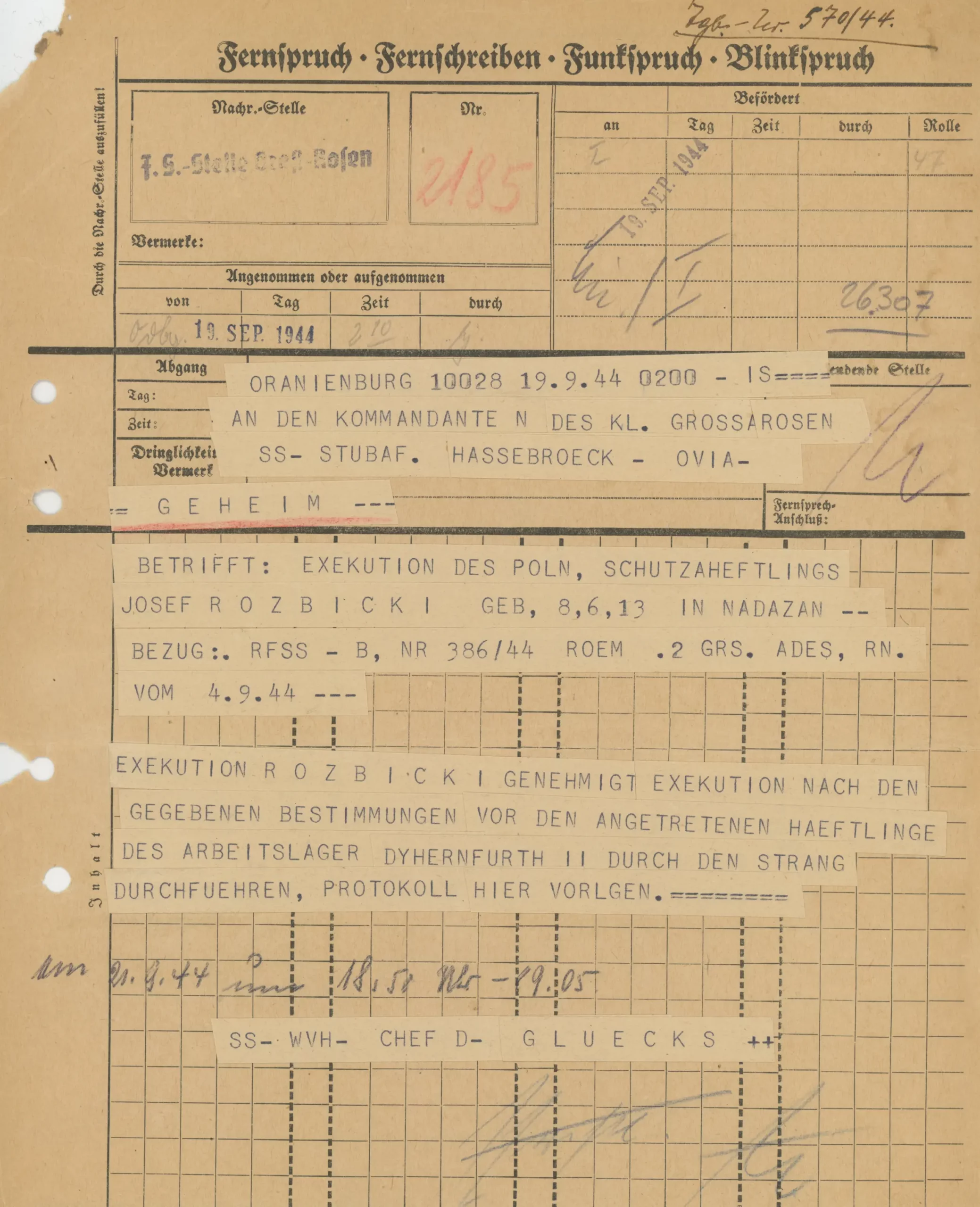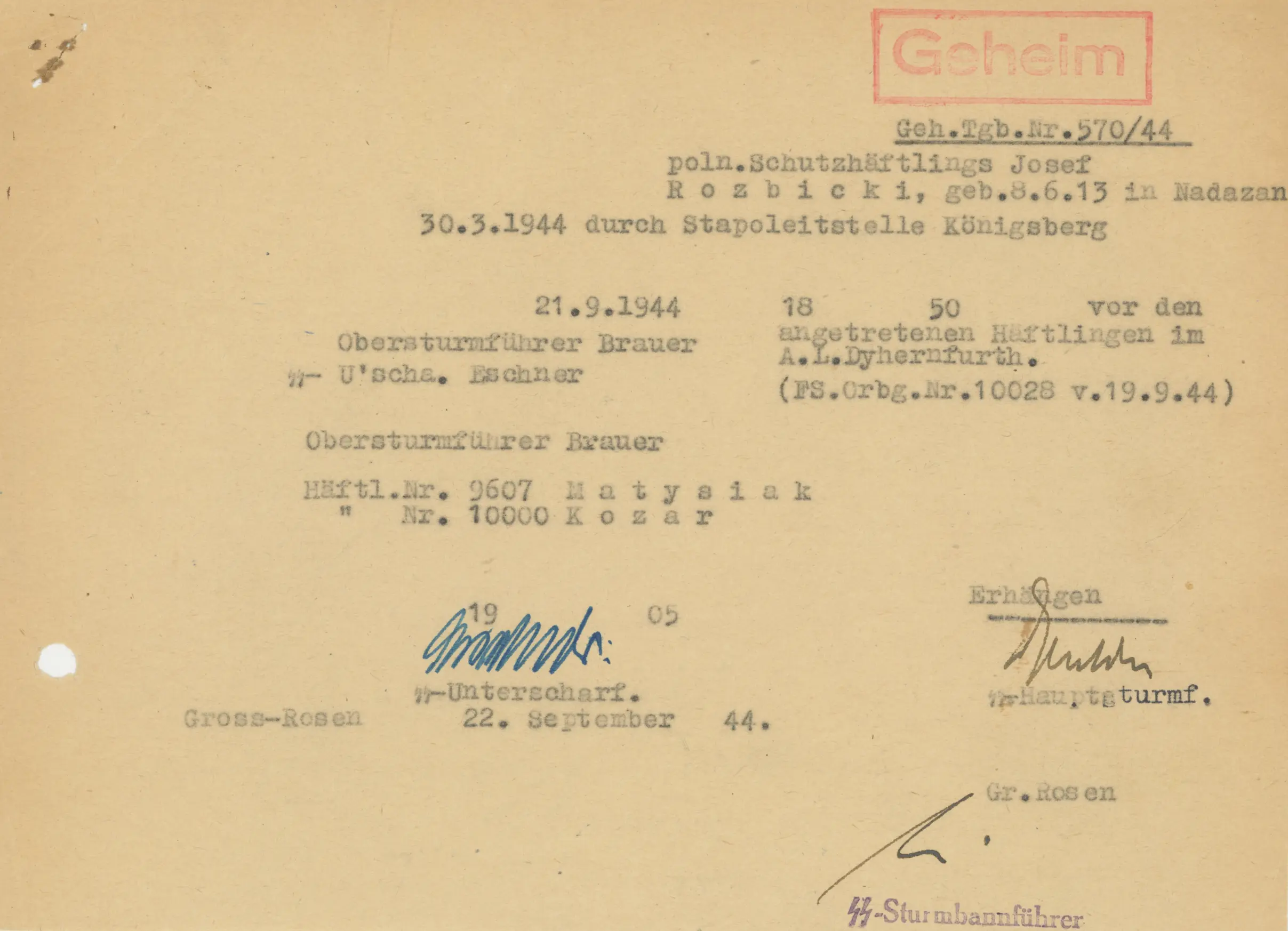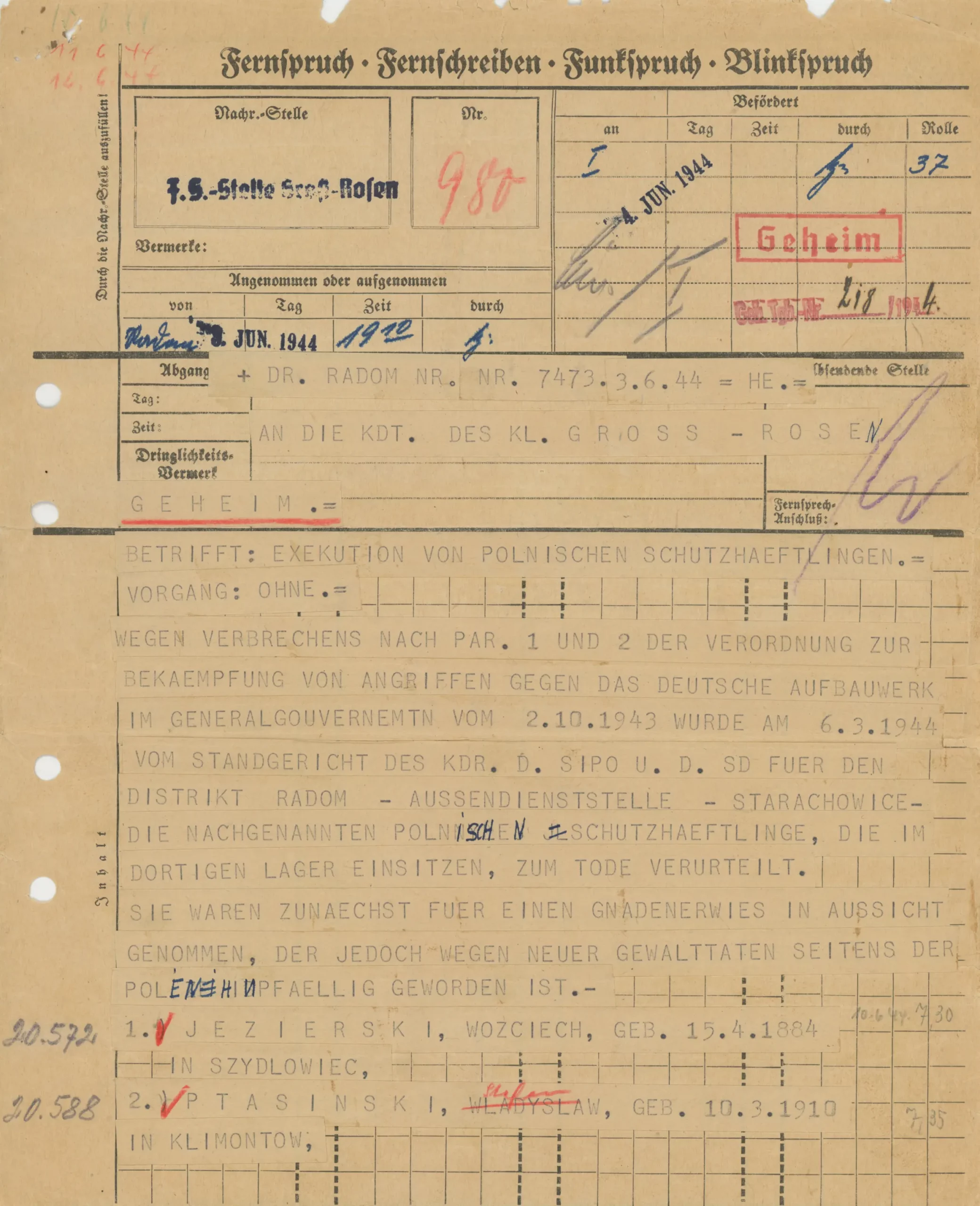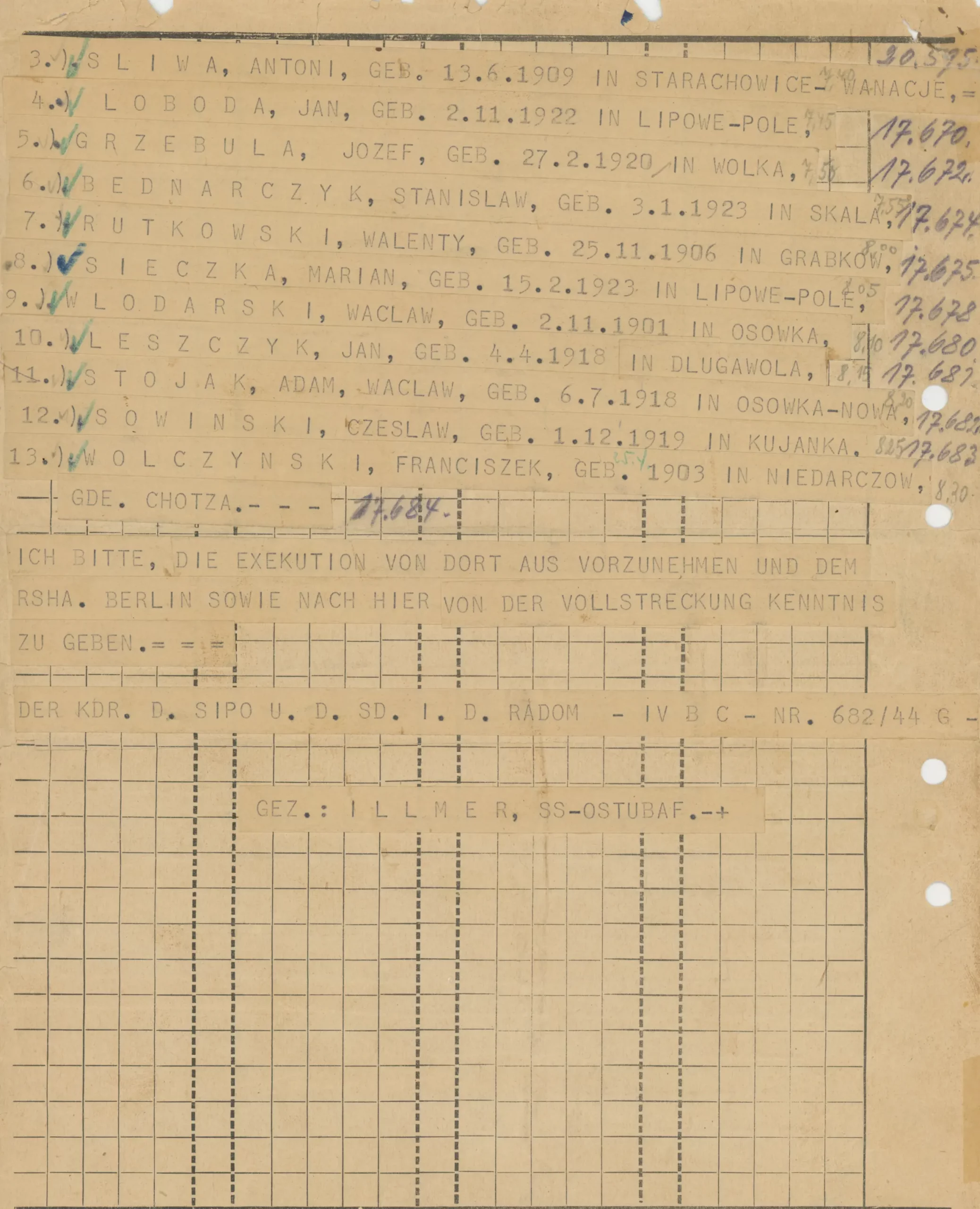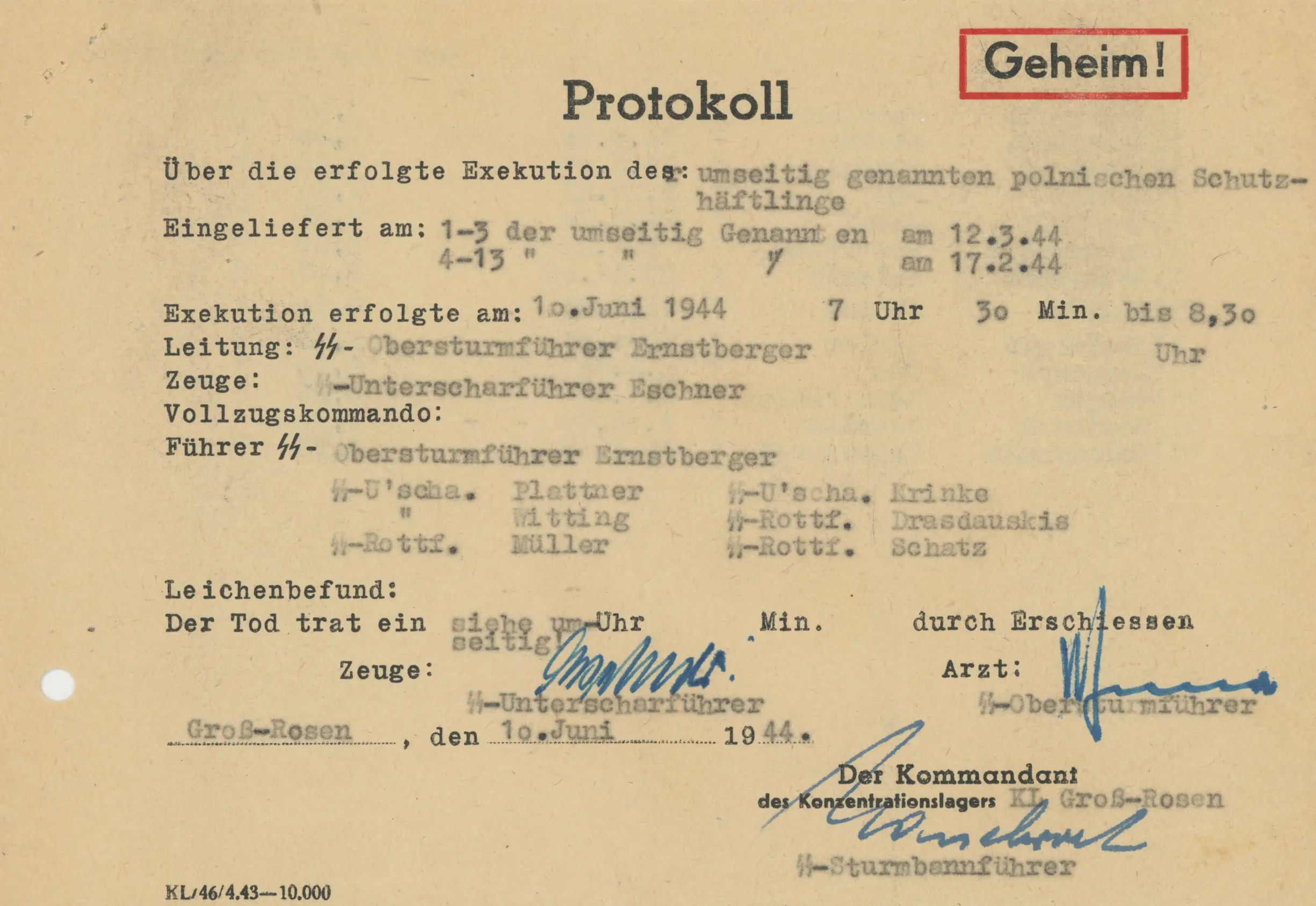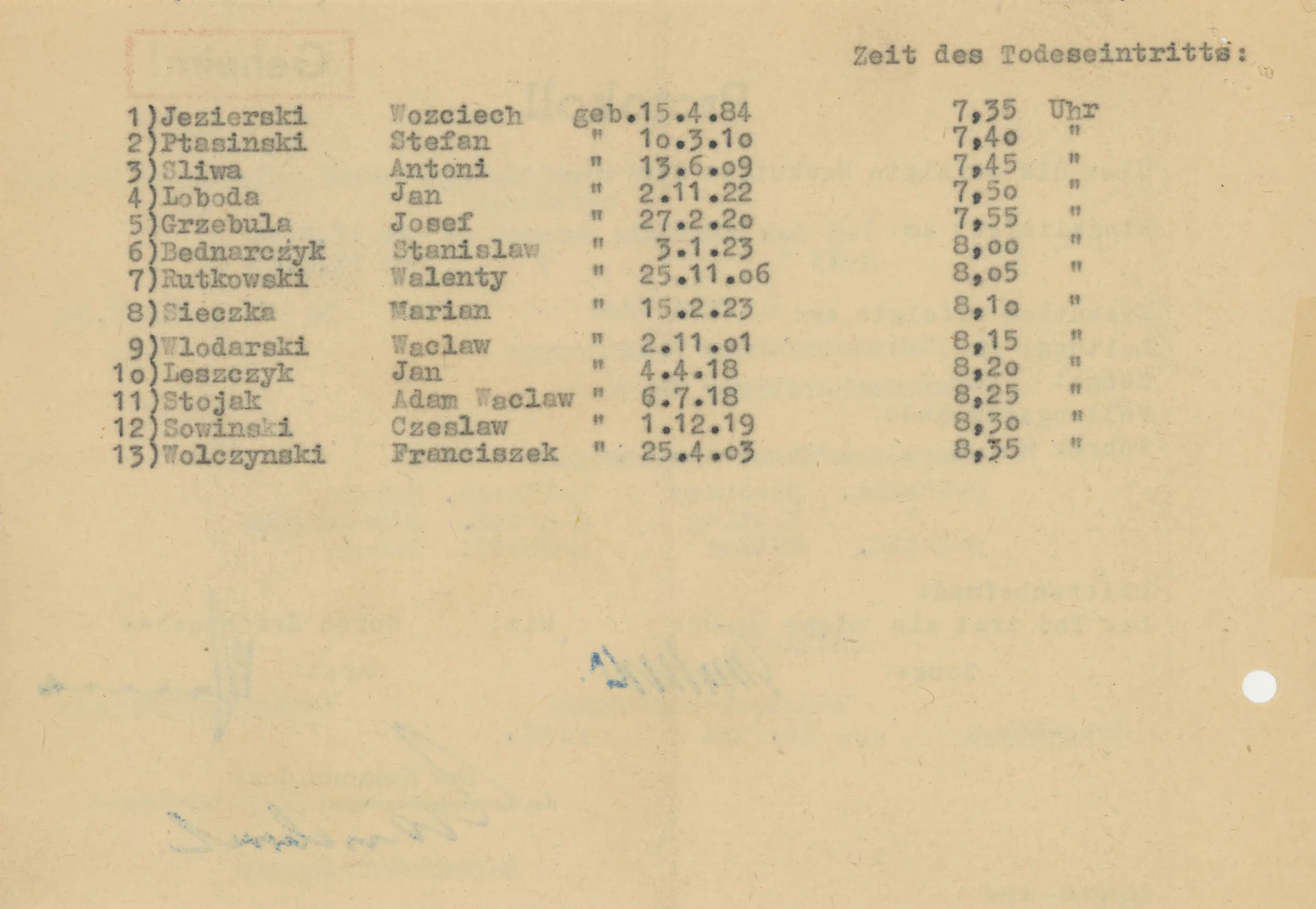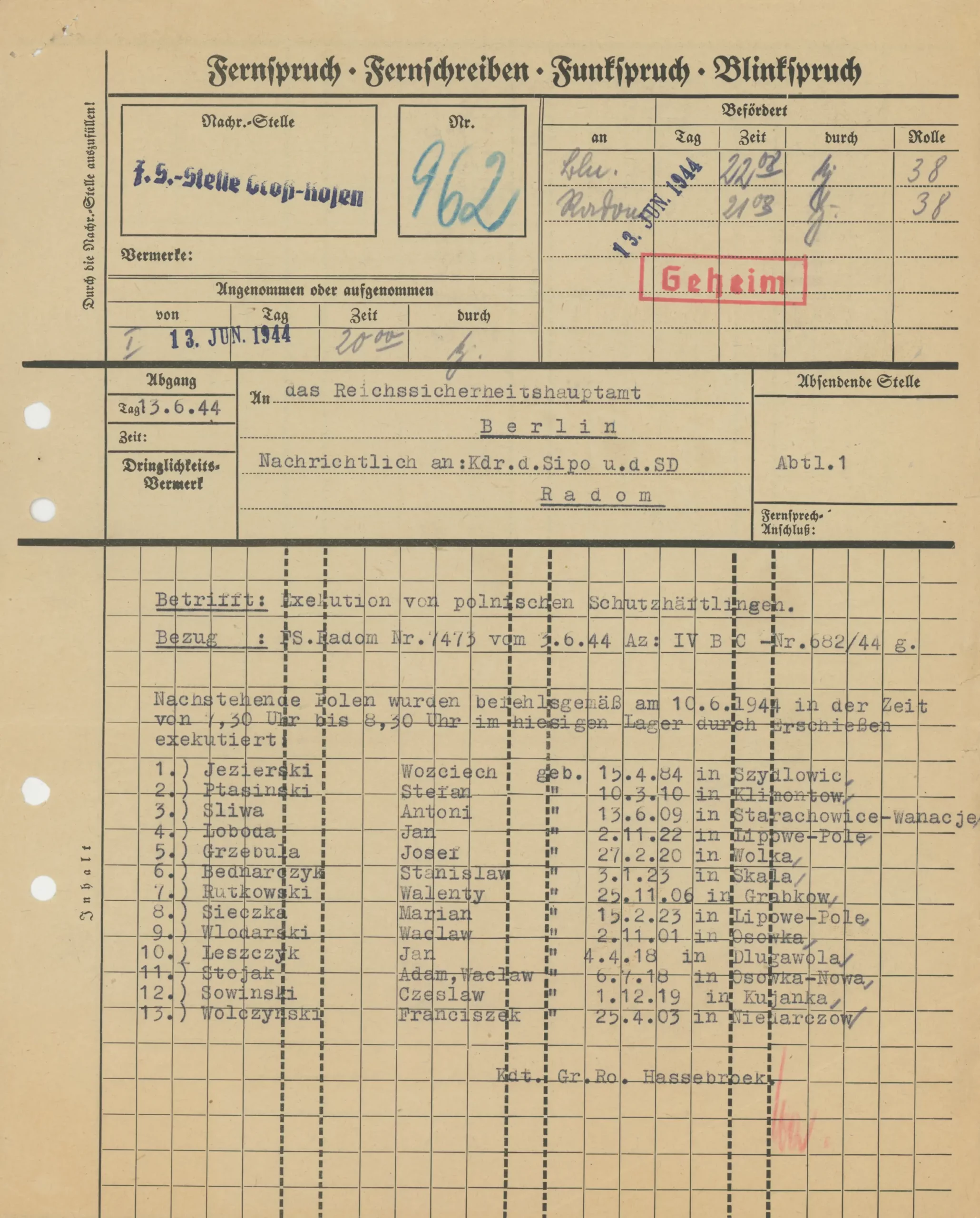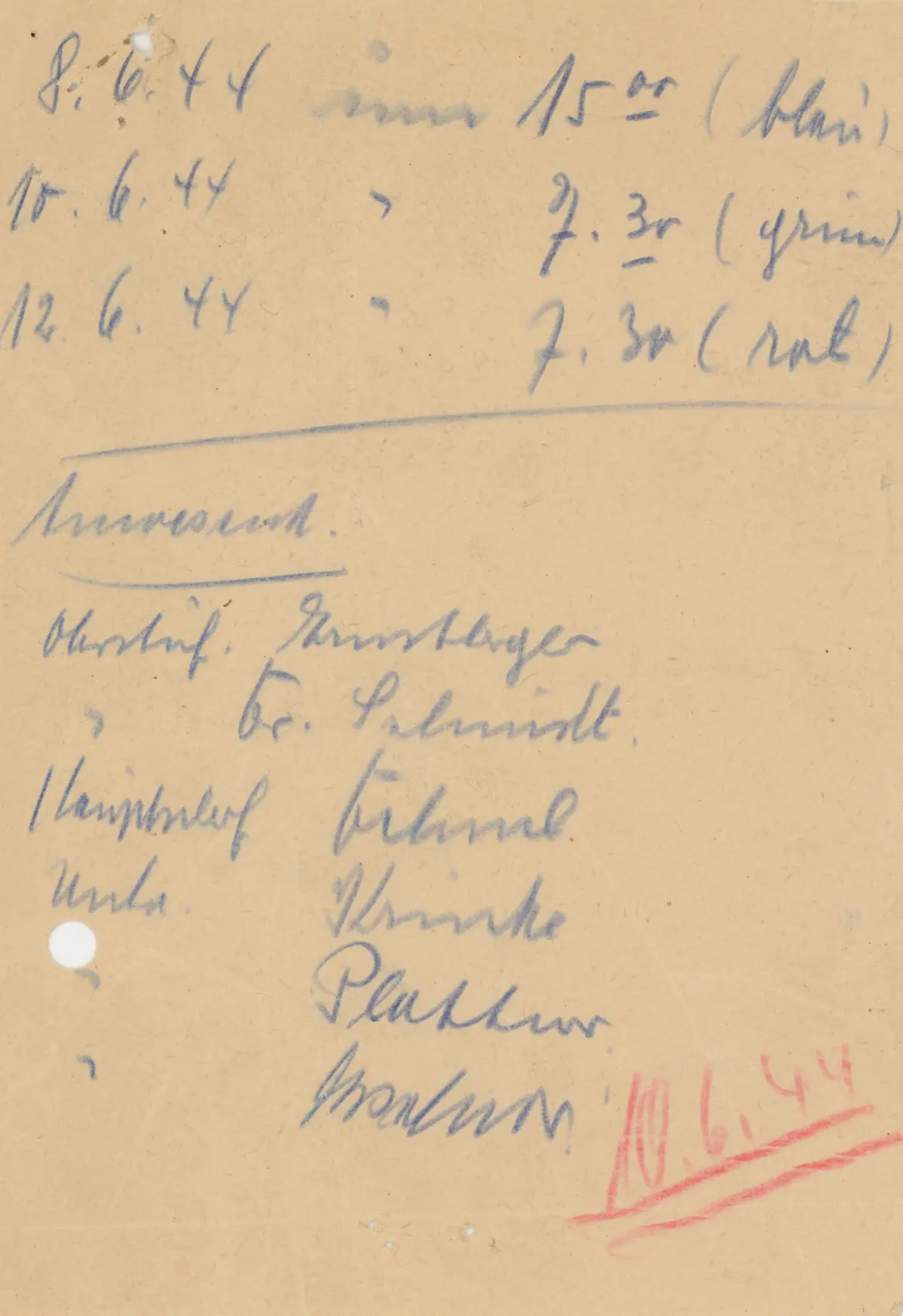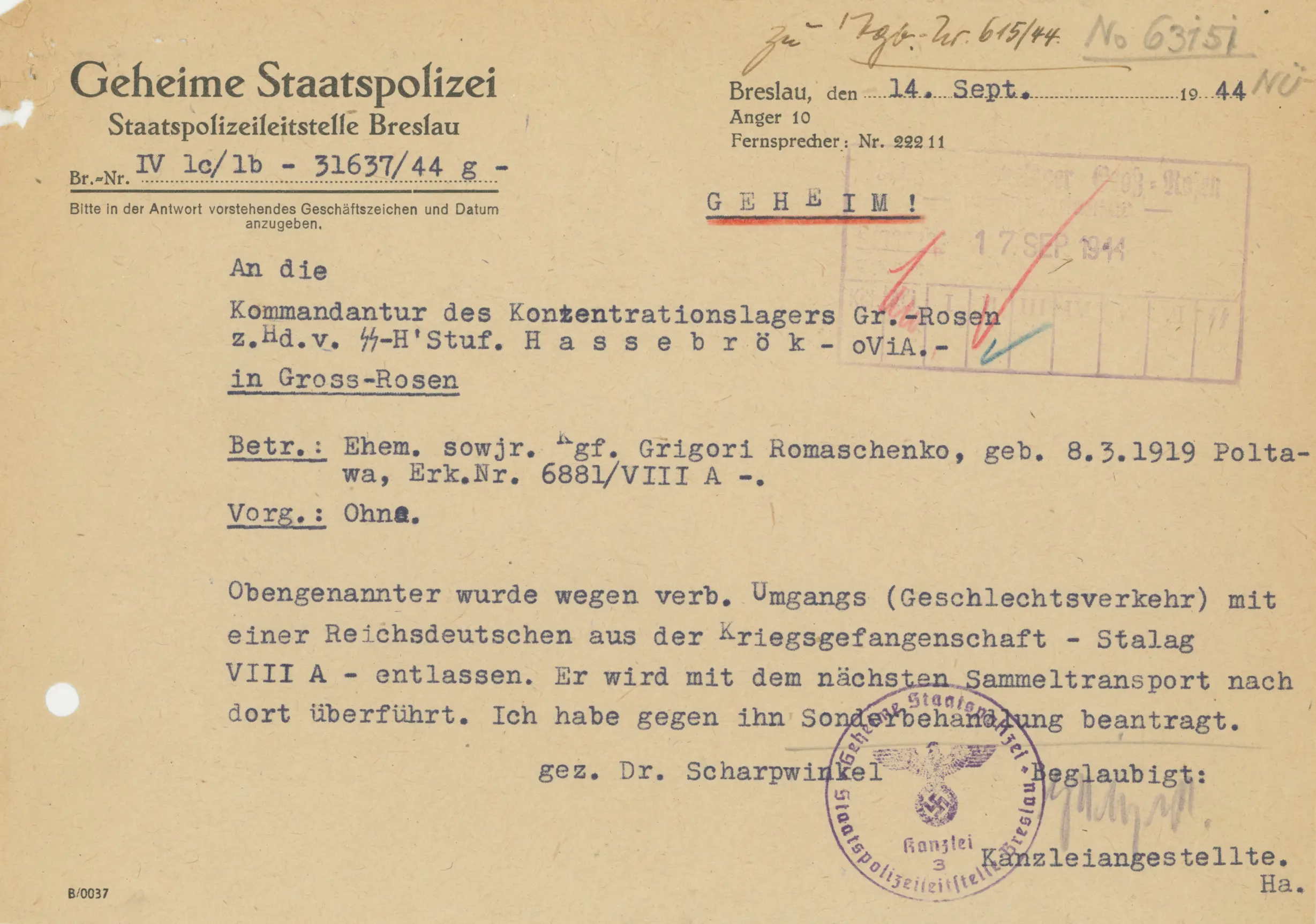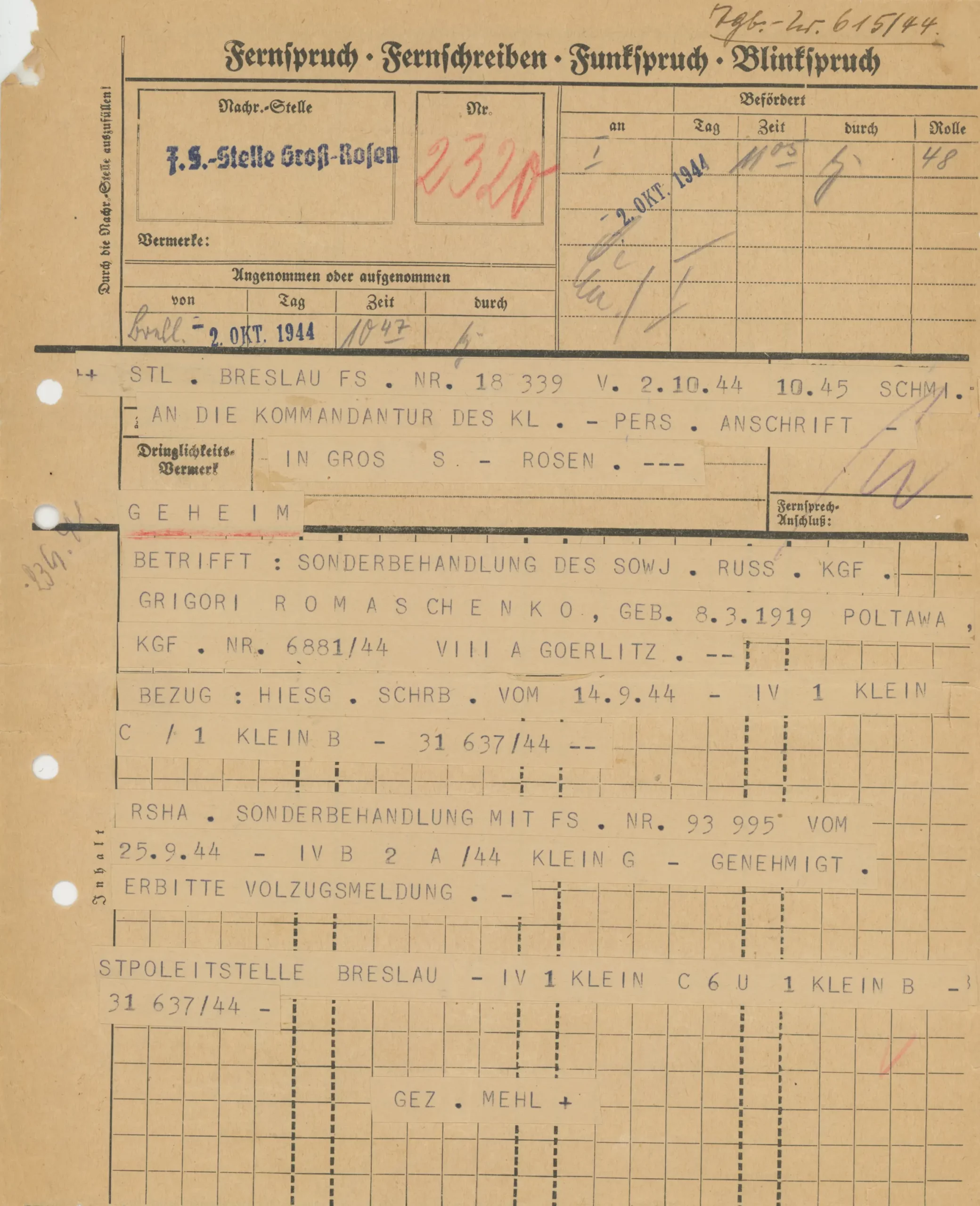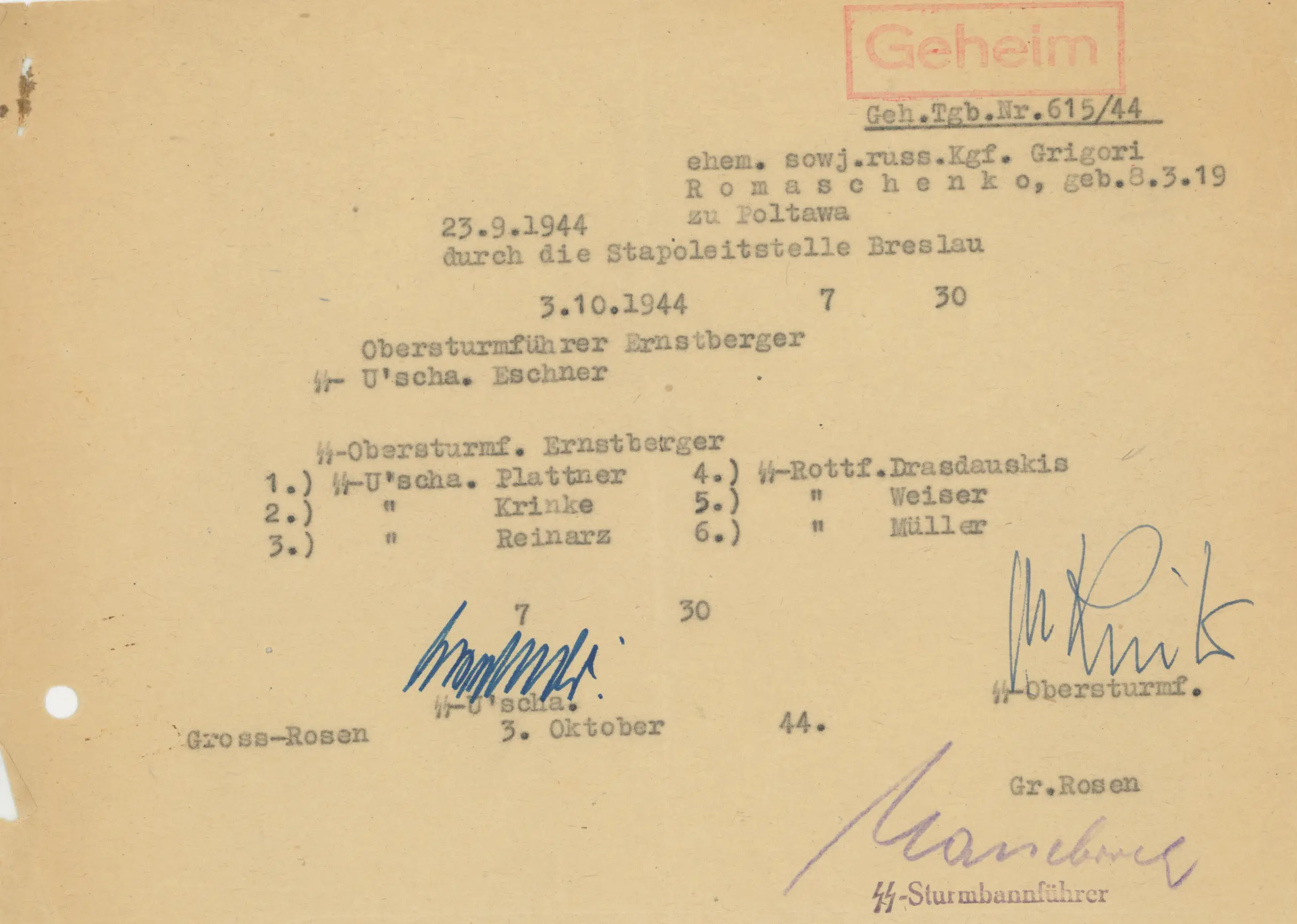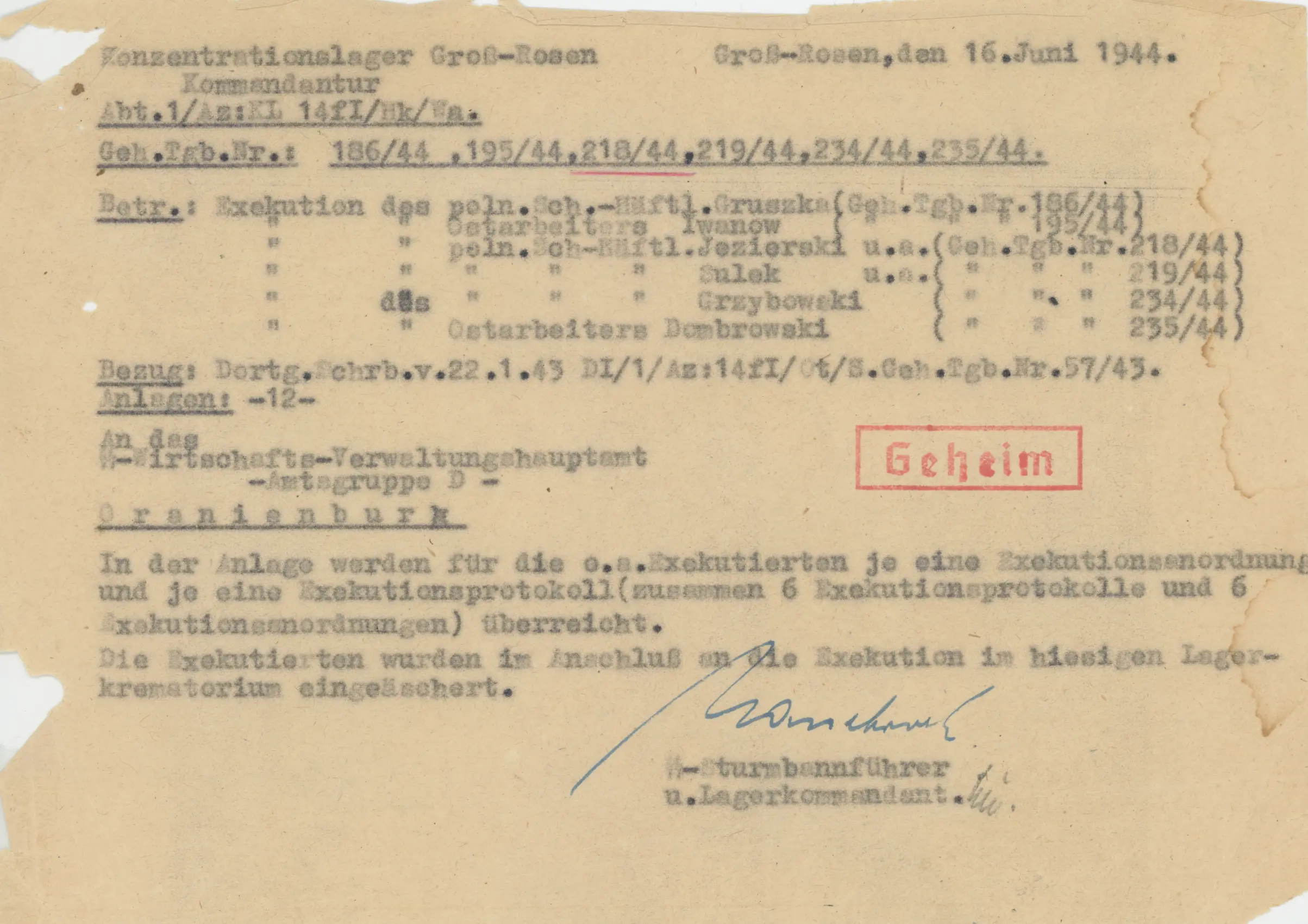Éxecutions au camp concentration Gross-Rosen
The following documents order and confirm executions of Polish prisoners at the Gross-Rosen concentration camp. This camp was originally established as a subcamp of the Sachsenhausen concentration camp in 1940. By May 1941 the camp in Lower Silesia operated independently. The camp further expanded and became the center of a network of more than 97 subcamps.
As in most of the concentration camps the prisoners at first worked in the construction of the camp and the quarry and later for the armament industry. Most of the prisoners were Jews and a third of the prisoners were women. The main camp and its subcamps were evacuated from January until early February 1945 and finally liberated by the Soviet forces on 13 February 1945.
Josef Rozbicki
Josef Rozbicki: Josef Rozbicki was born on 8 June 1913 in Nadazan, Poland. He was hung on 21 September 1944 at a subcamp of the Gross-Rosen concentration camp.
This telegram dated 19 September 1944 was sent from the Economic and Administrative Office of the SS in Oranienburg to the Commander of the concentration camp of Gross-Rosen. It concerns the execution of Polish inmate Josef Rozbicki. It reads:
“Subject: Execution of Polish inmate Josef Rozbicki born 8 June 1913 in Nadazan.
Execution of Rozbicki confirmed, execution is to be carried out in front of the inmates of the work camp Dyhernfurth II by hanging, record of execution must be forwarded.”
This document, dated 22 September 1944, reiterates that Josef Rozbicki was hanged 21 September 1944, and the time, 18:50. It is also mentioned that this took place in front of the assembled inmates. The execution was probably carried out by the SS-men Brauer and Eschner who are mentioned.
13 polish prisoners
13 Polish prisoners: The Polish prisoners Wozciech Jezierski, Stefan Ptasinski, Antoni Sliwa, Jan Loboda, Jozef Grzebula, Stanislaw Bednarczyk, Walenty Rutkowski, Marian Sieczka, Waclaw Wlodarski, Jan Leszczyk, Adam Waclaw Stojak, Czeslaw Sowinski and Franciszek Wolczynski arrived at the Gross-Rosen concentration camp on 12 March 1944 and 17 February 1944. They were shot on 10 June 1944 at the camp.
This telegram dated 3 June 1944 was sent from the martial court of the district of Radom in the General Government to the command of the Gross-Rosen concentration camp. It lists 13 inmates of “protective custody” in Gross-Rosen who are to be executed. Their birth dates and places of birth are methodically listed next to their names. The document reads as follows:
“Because of crimes against Section 1 and 2 of the “Order to Combat Attacks against the German Establishment of the General Government” (Verordnung zur Bekämpfung von Angriffen gegen das deutsche Aufbauwerk im Generalgouvernment) the following Polish inmates in protective custody were sentenced to death. At first, they were proposed for a grant of grace but due to new attacks by Poles the proposal was rendered void.
- Jezierski, Wozciech, born 15 April 1884 in Szydlowiec
- Ptasinski, Stefan, born 10 March 1910 in Klimontow
- Sliwa, Antoni, born 13 June 1909 in Starachowice-Wanacje
- Loboda, Jan, born 2 November 1922 in Lipowe-Pole
- Grzebula, Jozef, born 27 February 1920 in Wolka
- Bednarczyk, Stanislaw, born 3 January 1923 in Skala
- Rutkowski, Walenty, born 25 November 1906 in Grabkow
- Sieczka, Marian, born 15 February 1923 in Lipowe-Pole
- Wlodarski, Waclaw, born 2 November 1901 in Osowka
- Leszczyk, Jan, born 4 April 1918 in Dlugawola
- Stojak, Adam, Waclaw, born 6 July 1918 in Osowka-Nowa
- Sowinski, Czeslaw, born 1 December 1919 in Kujanka
- Wolczynski, Franciszek, born 1903 in Niedarczow, Chotza
I request that you carry out the execution and then notify the Reich Security Main Office in Berlin and also us here.”
This document dated 10 June 1944 was top secret. It is a report concerning inmates in “protective custody.” They on 12 March 1944 and 17 February 1944 in the camp. The executions took place on 10 June 1944 from 7:30 to 8:30 AM. The operation was led by Obersturmführer Ernstberger and witnessed by Unterscharführer Eschner. The executions were carried out by a unit consisting of the SS-men Plattner, Witting, Müller, Krinke, Drasdauskis and Schatz. The type of execution was shooting. On the back of the page the 13 killed Polish prisoners, their dates of birth and their time of death are listed. They were shot five minutes apart from one another for a total time of 65 minutes.
The Reich Security Main Office in Berlin sent this telegram to the martial court of the district of Radom in the General Government. The document dated 13 June 1944 lists 13 Polish prisoners, their dates and places of birth. It confirms that they were executed by firing squad as ordered on 10 June 1944, from 7:30 to 8:30 AM in Gross-Rosen.
These handwritten notes read:
“8 June 1944 at 3 pm (blue)
10 June 1944 at 7:30 am (green)
12 June 1944 at 7:30 am (red)”
The second date and time correspond to the Protocol concerning the executions of 13 Polish prisoners on 10 June 1944.
Underneath the date 10 June 1944 is written in red and the names of the SS-men are listed as follows:
“Obersturmführer Ernstberger
Obersturmführer Schmidt
Hauptsturmführer […]
Unterscharführer Krinke
Unterscharführer Plattner
Unterscharführer […] (same signature as witness on Protocol)”
Some of the names correspond with the names of the SS-men on the Protocol who carried out the executions of the 13 Polish Prisoners.
Grigori Romaschenko
Grigori Romaschenko: Grigori Romaschenko was born on 8 March 1919 in Poltawa, Soviet Union. He was sent to the Gross-Rosen concentration camp because of “prohibited contact with a German woman.” On 3 September 1944, Romaschenko was killed at the camp.
This letter dated 14 September 1944, was sent from the German Secret State Police at the State Police Regional Headquarters in Breslau to the command of the Gross-Rosen concentration camp regarding former Soviet prisoner of war Grigori Romaschenko who was born on 8 March 1919 in Poltawa. The letter states that the prisoner was released from their custody because of his prohibited contact (sexual intercourse) with a German woman. He would be transported there with the next group transport. The sender requested “special treatment” for the prisoner.
On 2 October 1944, the State Police Regional Headquarters in Breslau wrote to the command of the concentration camp Gross-Rosen. The telegram concerns “special treatment” for Russian prisoner of war Grigori Romaschenko. The State Police Regional Headquarters in Breslau has authorized “special treatment.” The sender requests notification that it has been carried out.
This document, dated 3 October 1944, makes reference to former Russian prisoner of war Grigori Romaschenko. Execution or killing is not mentioned but the time and date (7:30 am on 3 October 1944) correspond with the telegram sent to the State Police Regional Headquarters in Breslau confirming the execution of Grigori Romaschenko. The SS-men Ernstberger, Eschner, Plattner, Krinke, Reinarz, Drasdauskis, Weiser and Müller are mentioned. They probably carried out the execution.
Additional Executions
This document dated 16 June 1944, was sent from the command of the Gross- Rosen concentration camp to the Economy and Administration Main Office in Oranienburg. It states the executions of the inmates Gruszka, Iwanow, Jezierski, Sulek, Grzybowski, and Dombrowski. It further reads: “At the camp one execution order and one execution protocol for each aforementioned inmate (6 execution orders and 6 execution protocols in total) are issued. After the execution, the corpses were cremated in the camp.”

